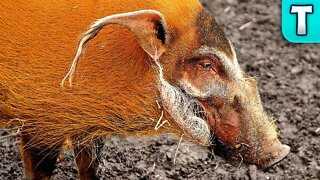Okapi | World's Weirdest Animals
Living in in the African jungle is an animal in a state of decline. On this episode of world’s weirdest animals we bring you the Okapi.
Being the only living relative of the giraffe, the okapi resides in the central, eastern and northern parts of the Congo.Living among damp and dense rainforest vegetation, this large mammal weighs on average between 440 - 700 lbs or 200 to 317 kg. They can grow as tall as 6 and a half feet or almost 2 meters tall and have a body length of over 8 feet or 2.4 meters long. Looking like a mix of a giraffe and a zebra the okapi features horizontal black and white stripes on their legs with a velvety maroon colored body, white head and black snout.
The female okapi are larger than the males. Males have horns covered in skin whereas females have small bumps in the same place. The horns on the males won’t grow very long making it easy for them to sift through the rainforest jungle plants. Within their mouth resides a 1.5 foot or almost half a meter long tongue that can reach and clean both their eyes and ears. This prehensile tongue is also used to pull leaves from branches to eat but that isn’t all they eat. They are known to chow down on twigs, grass, ferns and fruit as well. In search for food later in the day around dinner time the okapi will travel up to 2.5 miles or 4 km a day just to eat. Being a ruminant the okapi swallows and regurgitates its food many times just as a cow would. While munching their way through the forest, the okapi can actually rotate their eyeballs back into their head to avoid damaging them.
A Territorial and solitary creature in nature the okapi will mark their surroundings with their urine and a foul smelling gooey tar like substance. During mating season, the female will let out a call for a male. They will spend a couple weeks together before the male moves along. The female will be pregnant for up to 16 months before giving birth. Baby okapi will spend their first 2 months of life hidden in dense forest vegetation. They won’t even poop for the first months which would potentially provide a scent trail for leopards to find them. Young okapi will look the same as the adults except for a ridge of hair along the spine that will go away over time.
Having excellent sense of hearing the okapi have large ears which alert them of danger. If their sensitive hearing doesn’t pick up predator movement than their keen sense of smell will. The leopard, being the only natural predator of the okapi carries minimal responsibility for the decline of this species. Discovered in 1900 with numbers around 45,000 total, today there are only around 10,000 okapi left. Listed as near threatened, it’s likely this animal will become endangered as massive amounts of deforestation along with bacterial, fungal and viral infections are to blame for the decline of their numbers.
In the wild the okapi will live for around 20 - 30 years as long as humanity does it’s part to give them that chance.
Footage:
https://www.youtube.com/watch?v=sPUhybZ_xMU
https://www.youtube.com/watch?v=e6axPY96IXg
https://www.youtube.com/watch?v=YxQ7Oa4lHyY
https://www.youtube.com/watch?v=m0dgM1zrfSY
#weirdanimals #okapi #animals
Check out some of our other videos:
Top 10 Fruits You’ve Never Heard Of Part 2
https://www.youtube.com/watch?v=hRdgPyZF45g&feature=youtu.be
Top 10 Fruits You’ve Never Heard Of
https://www.youtube.com/watch?v=OKTej1u-7-0&feature=youtu.be
Support TTL by using our amazon link: http://amzn.to/2dQQ4nu
Subscribe to our channel! → http://bit.ly/subscribe_to_titantoplist
For copyright matters please contact: titantoplist@gmail.com
Intro music thanks to Machinmasound:
Rallying the Defense:
https://www.youtube.com/watch?v=ruPk4RD19Nw
Titan Top List is a participant in the Amazon Services LLC Associates Program, an affiliate advertising program designed to provide a means for sites to earn advertising fees by advertising and linking to amazon.com
-
 9:29
9:29
Earth Titan
7 months agoGHOST PUBLIC LANDS Camp and Cook | VANLIFE in Paradise
164 -
 2:21
2:21
Earth Titan
2 years agoRed River Hog | World's Weirdest Animals
93 -
 1:44
1:44
Hack
1 day agoHow to Unlock Your Car in 30 Seconds
6.71K11 -
 8:06
8:06
ErmzPlays
18 hours agoThe Acolyte Episode 4 - From Stupid To Insane
3.21K7 -
 10:12
10:12
China Uncensored
8 hours agoBoeing Has a BIG China Problem
5.56K15 -
 1:02
1:02
Maicy Renee
11 hours agoGetting That Beach Body Ready Yall!
11.2K4 -
 42:43
42:43
The Why Files
1 day agoProof of Life After Death: Hope and a Warning From The Other Side
18.2K57 -
 16:37
16:37
Scammer Payback
1 day agoHere's the Scammer's Location 👉 (28°34'05.1"N 77°24'00.9"E)
22.4K19 -
 2:42:09
2:42:09
Fresh and Fit
7 hours agoSmash A Guy In The Friend-Zone Or Dinner With Mustache Man?
65.2K62 -
 4:56:08
4:56:08
Alex Zedra
7 hours agoLIVE! Playing Chained Together
31.4K28